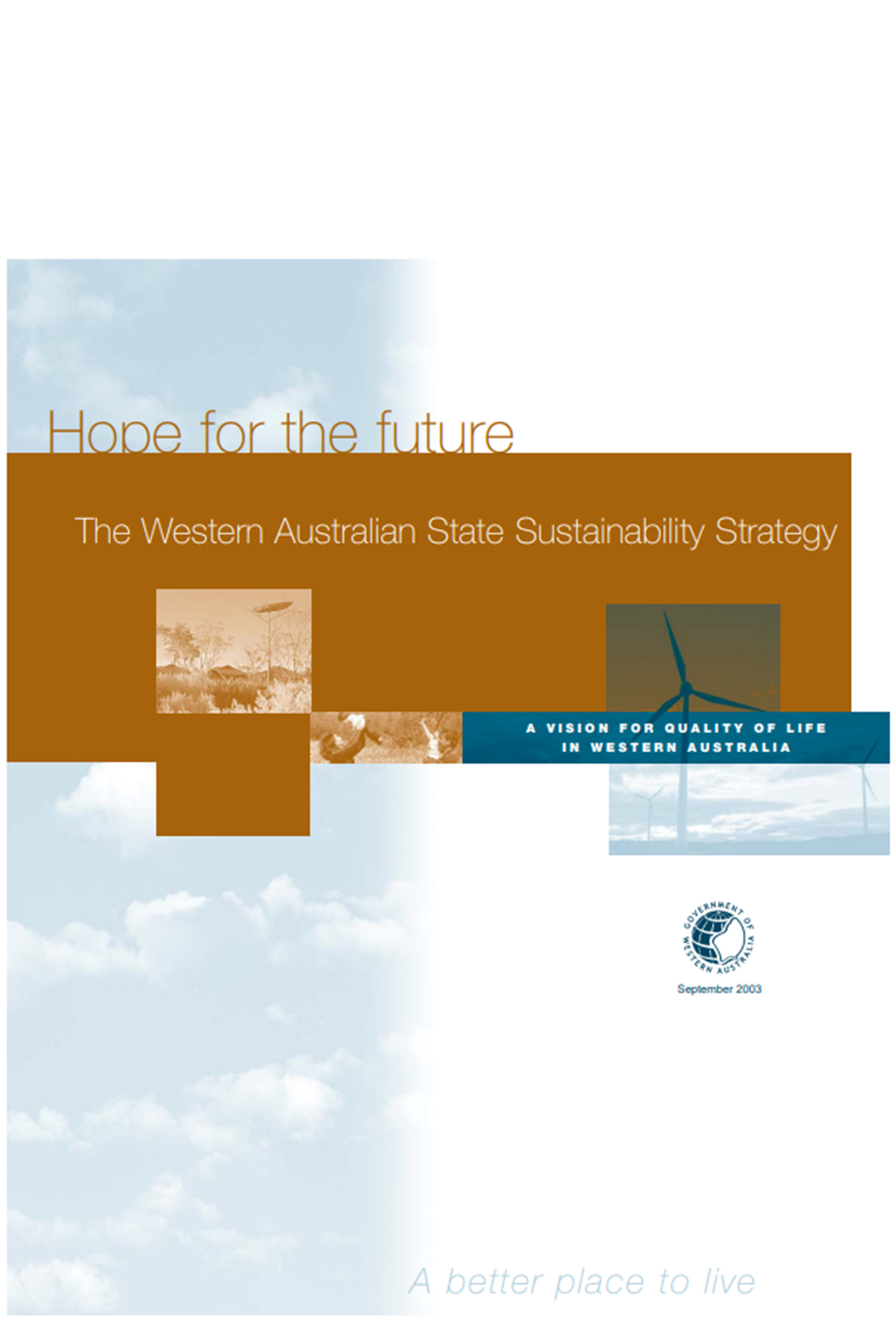Learning & Reading Materials
WA’S State Sustainability Strategy (A Model Sustainability Strategy for Educational Purpose)
Western Australia’s State Sustainability Strategy (SSS)
The policy champion – Dr Geoff Gallop
In Western Australia’s case, the policy learning process story is more related to Dr Geoff Gallop rather than the Western Australian Labor Party of that period. This is because Gallop himself was instrumental in formulating the idea of the state sustainability strategy. Dr. Gallop was an academic-turned-politician who strongly believed in the sustainability agenda, supported gender equality, and was committed to Aboriginal well-being. His premiership fulfilled his election promises by stopping old-growth forest logging (Martin & Christof, 2011a), addressing water issues, and responding to the Aboriginal community’s concerns following the Gordon Inquiry. He was awarded the Order of Australia (AC) for promoting the economic and environmental sustainability agenda (Schoubroeck, 2010). Dr Gallop was critical of the idea of considering the Gross Domestic Product as the sole benchmark to measure a society’s progress and strongly advocated for an alternative indicator of progress. In 1996, at a speech to the Economic Society of Western Australia, Dr Gallop argued that:
… Let’s return to Western Australia and the current political debate. The Liberal and Nationals refer to the state version of GDP, the Gross State Product (GSP), as the measure of progress. This not only provides us with a bad guide to well-being in the community but also guides the policy process in the wrong direction. It is clear that the public wishes to see balance in our society and economy, but this cannot be achieved with a single-minded pursuit of GSP. No longer ought we to pursue our economic objectives independently of our social and environmental objectives, but how is that possible when we only measure economic outcomes, and indeed, economic outcomes that are narrowly conceived… (Gallop 1998, pp.102-103)
In addition, he also acknowledged the gap in perspectives on land management between European settlers and Aboriginal communities (Phillips & Black 2005). Gallop was a champion for the social justice and sustainability agendas. These values were reflected in his selection of portfolios and the patronage of policy issues during his premiership. In the early phase of his tenure, he created a Sustainability Round Table and later converted it into the Sustainability Policy Unit within the Department of the Premier and Cabinet. This also fulfills the pre-election promise to set up an Ecologically Sustainable Development Unit. Schoubroeck’s book ‘The Lure of Politics’ mentions that “Sustainability he led from his office because it was fundamental to what he believed in” (Schoubroeck 2010, p.171). To explain how Western Australia’s “Sustainability Strategy” was introduced during Gallop’s premiership, one of the interviewees for the study stated that
… he [Prof. Peter Newman] heavily influenced Geoff Gal lop…but it was not like that…he was not forcing it on to Geoff…Geoff was already a [champion] of the [agenda] and was quite keen about the idea [the formulation of an overarching Sustainability Strategy]…
Dr Gallop’s writings and public lectures also demonstrated that he strongly advocated state strategic planning within the public sector. He wanted to integrate whole-of-government objectives through a strategic plan for the government. He was also keen to incorporate holistic sustainability values into public policy. He identified the weaknesses of the New Public Management’s governance model as it concentrated on an individual public agency’s performance rather than on the collective performance of all public agencies. Hence, he advocated for strategic planning within the government. In many of his public speeches and writings, he mentioned the growing trend among Australian states to adopt whole-of-government strategic planning. He also explained how holistic sustainability values could be incorporated into the state strategic plan. Dr Gallop believed that integrating these two aspects into public policy was the most natural and compatible step for good governance.
A good government ought to be focused on this complex range of interests. The principle of sustainability demands that it does (Gallop 2011, p.374). It was not a huge leap from these developments to a commitment to sustainability and the triple bottom line. This concept and the philosophy of government attached to it provided a solid framework for policymaking and implementation. Indeed, each of the state governments set about putting flesh on the bones through the creation of state plans (Gallop 2007, p.30)
The State Sustainability Strategy policy document highlighted the state’s critical historical environmental and social issues and provided a strategy to mitigate these issues by adopting a sustainable development model. Some of the issues highlighted were the deterioration of 4.4 million hectares of land due to soil salinity, the effects of over-grazing on endangered plant species, the marginalization of the Aboriginal community, a decline in population growth, and the economic disparity of rural communities and some parts of Perth’s metropolitan area. The Strategy borrowed its moral and intellectual standpoint from the United Nations Brundtland Commission, Agenda 21, and the National Strategy for Ecologically Sustainable Development—the Strategy aimed for a smooth transition towards a sustainable future. The Strategy also proposed drafting a Sustainability Act for the state and formulating a ‘Sustainability Code of Practice for government Agencies’.
The Strategy prescribed a Sustainability Action Plan for energy consumption, greenhouse emissions, waste minimization, community engagement, sustainability procurement, formulating a Sustainability Assessment Model, and regularly publishing a State Sustainability Report. In addition, the Strategy proposed the development of a State-Local Government Sustainability Partnership Agreement.
The Strategy defines sustainability as “meeting the needs of current and future generations through integrating environmental protection, social advancement, and economic prosperity” (Sustainability Policy Unit 2003).
Overall, the strategic framework consisted of :
∅ Seven foundation principles and four process principles,
∅ Six visions for Western Australia’s sustainability,
∅ Six goals for the government and 42 priority areas for action.
The Strategy’s foundational principles were to achieve long-term economic health, maintain social equity and human rights, protect biodiversity and ecological integrity; develop an efficient settlement plan, promote a sense of place and respect for heritage, measure net benefit from development, and achieve the ‘common good’ through the planning process.
The steps to achieve these principles were by integrating the triple bottom line concept into assessment, promoting accountability, transparency, and engagement, and adopting precautionary actions.
In order to extol the positive long-term impact of the State Sustainability Strategy on Western Australia, Steve Davidson of ECOS magazine described the plan as a bold blueprint’. Further, he compared its path-breaking influence with the following analogy: ‘Western Australia may be behind the eastern States in terms of time, but the WA Government has stolen the march regarding sustainability policy.’
Goswami, K. and Gerritsen, R. (2021), ‘The Hidden Successes of Three Sustainability Policies – Evidence from Three Australian States’, (eds) Hunter, A.J., ACSDRI-Knowledge Press & Green Hill Academic, Adelaide, South Australia. ISBN: 978-0-6452550-0-3 & 978-0-6452550-1-0

